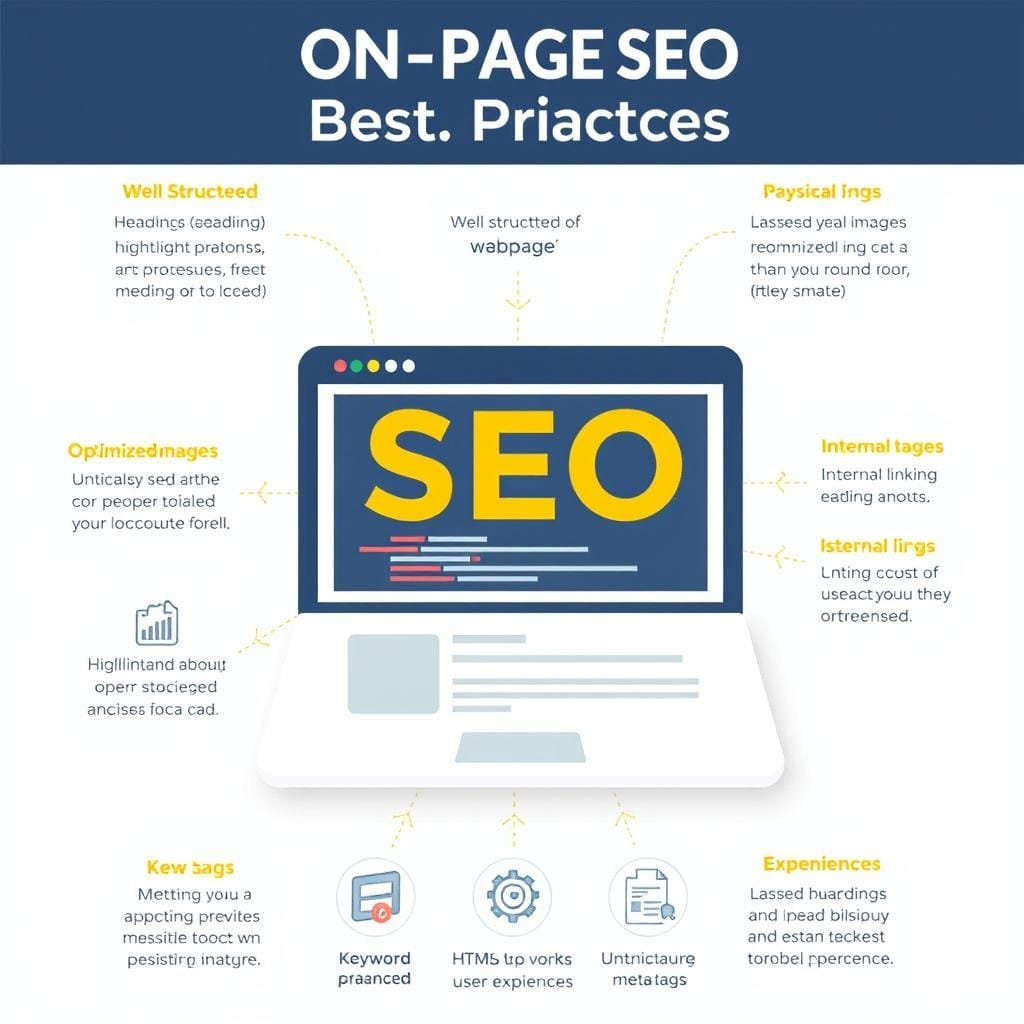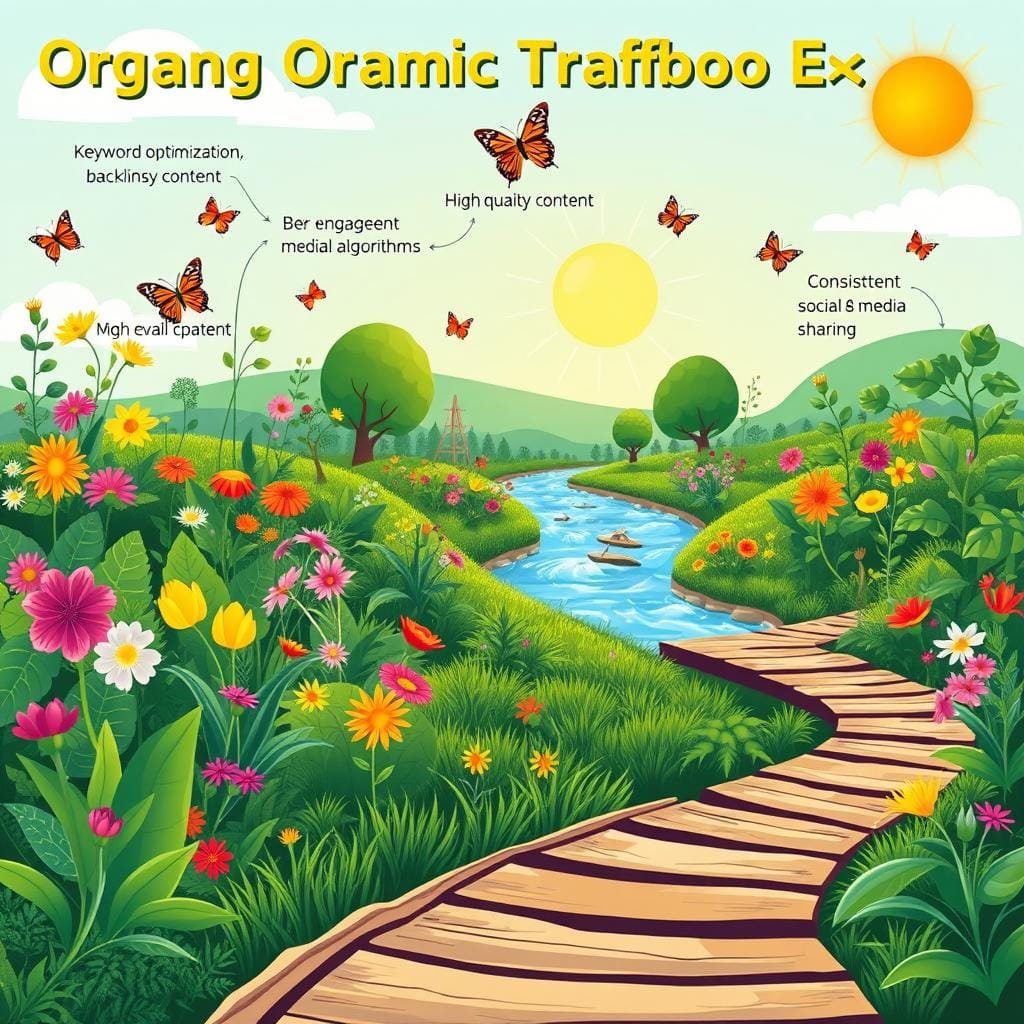Welcome! If you want to boost organic traffic to your site, you’re in the right spot. This guide will give you practical steps to improve your website’s organic traffic. Organic traffic means people who find your content without searching for it, like through search engines or social media.
Did you know 32% of people in the U.S. search online for local businesses often? This shows how important it is to have a strong online presence. Organic traffic can help you get more leads without the costs of paid ads. This approach can bring big returns on your investment.
This guide is for beginners and aspiring entrepreneurs. You’ll learn how to draw the right audience to your site and keep your content fresh. So, let’s explore the world of organic traffic and see how to reach your business goals!
Understanding Organic Traffic: What It Is and Why It Matters
Organic traffic is key for your online success. Knowing how it works can boost your website’s performance. This part explains what organic traffic is and why it’s crucial for your business.
Definition of Organic Traffic
Organic traffic means people visiting your site from search results without paying for ads. It’s different from paid traffic, which costs money. Your site’s ranking in search results determines organic traffic. It shows that your SEO and content quality attract visitors.
Importance of Organic Traffic for Websites
Organic traffic is very important. It’s free and brings in people who are likely to be interested in what you offer. Unlike ads, it doesn’t need constant money to keep going.
Good SEO helps your site be seen more online. This can make people more likely to buy from you. For more on this, check out this article on direct and organic.
In today’s digital world, organic traffic is a big part of your visitors. Being high in search results can make your brand more trusted. By creating valuable content, you meet your audience’s needs and wants.
Key Factors Influencing Organic Traffic
Knowing what affects organic traffic can really boost your online presence. SEO, content quality, and user experience are key. Let’s explore each important area.
Search Engine Optimization (SEO)
SEO is crucial for getting more organic traffic. It makes your site better for search engines. Good SEO means:
- Improving your site’s structure
- Using the right keywords in your content
- Keeping up with search engine updates
Content Quality and Relevance
Quality content draws in visitors who find it helpful. Content that meets their needs keeps them engaged. Important points include:
- Updating your content often
- Creating content that answers their questions
- Using keywords to improve interaction
User Experience (UX)
Good user experience makes visitors happy and keeps them around. A user-friendly site encourages exploration. Key UX elements include:
- Making it easy to find what you need
- Ensuring pages load quickly
- Using clear formats for your content
Conducting Effective Keyword Research
Keyword research is key to your keyword strategy. It helps you find out what people are looking for in your niche. By using the right tools, you can make your content better and get more visitors.
Tools for Keyword Research
Tools like SEMrush, Ahrefs, and Google’s Keyword Planner are very helpful. They give you data on how often people search for certain words. They also suggest long-tail keywords to make your content more specific. Here’s a quick look at some top tools:
| Tool | Key Features | Monthly Searches Capacity |
|---|---|---|
| SEMrush | Competitor analysis, keyword suggestions | High |
| Ahrefs | Extensive backlink analysis, keyword ideas | Very High |
| Google Keyword Planner | Free tool, search volume data | Medium |
Long-Tail vs. Short-Tail Keywords
Knowing the difference between short-tail keywords and long-tail keywords is important. Short-tail keywords, like “shoes,” get a lot of searches but have lots of competition. Long-tail keywords, like “comfortable running shoes for women,” are more specific and less competitive. They often lead to more sales because they match what people are really looking for.
Using both types of keywords in your content can help you reach more people. While high-volume keywords might seem attractive, focusing on less competitive keywords can bring in better quality traffic. Finding the right balance is the key to success.
On-Page SEO Best Practices
Improving your website’s search engine visibility is key. This section covers three important areas: optimizing meta tags, making content easy to read, and using internal links.
Optimizing Meta Tags
Creating catchy title tags and meta descriptions is crucial. They grab attention in search results. Even though a study found no direct link between keyword-rich tags and top rankings, top pages often include exact keywords in their titles.
Google suggests making your meta descriptions unique. This can help your page stand out and increase clicks.
Enhancing Content Readability
Keeping your content easy to read is essential. Use short paragraphs, headings, bullet points, and simple language. Tools can help check and improve your content’s readability.
When your content is easy to read, people tend to stay longer on your site. This boosts engagement.
Internal Linking Strategies
Internal linking makes your site easier to navigate. It connects related pages, helping visitors understand your content better. Google recommends strong internal linking for better SEO.
For more tips, check out this resource.

Creating High-Quality Content
Making high-quality content is key for boosting organic traffic. It’s not just about writing. It’s about being original and adding value. Let’s look at how to make content that stands out and connects with your audience.
Importance of Originality
Being original in your content is vital. Unique content makes you stand out in a crowded field. It attracts backlinks, boosting your visibility and engagement.
Readers love fresh views, which builds trust and keeps them coming back. Companies with blogs get 97% more links, showing the power of original content. Sharing real stories with your audience keeps them interested in your brand.
Incorporating Visuals
Adding visuals to your text can really boost engagement. Studies show people do 323% better when following instructions with pictures. Images, infographics, and videos make your content more engaging and easier to understand.
They also help with SEO. Good content strategies use visuals to create a rich experience. This draws in more visitors who are likely to share your content.
Content Length and Depth
There’s no one-size-fits-all for content length, but deeper articles usually do better. In-depth analysis builds your authority and helps you rank higher on search engines. Focus on adding valuable insights and examples.
Keeping your content fresh and updated can also increase traffic. Google favors sites with current information. Aim for content that meets user needs and boosts your search rankings and site engagement.
Make sure to check out effective ways to boost organic traffic through high-quality content creation and other strategies.
Leveraging Technical SEO
Improving your website with technical SEO is key to getting more organic traffic. It focuses on site speed, mobile optimization, and structured data markup. Let’s explore how these areas boost your website’s performance and SEO success.
Site Speed Optimization
Fast-loading pages are crucial for a good user experience. Google values site speed, making it vital for your site to load quickly. Use Google PageSpeed Insights to check your site speed and find ways to improve.
Optimizing images and reducing HTTP requests can make your site load faster. Faster sites rank better, have lower bounce rates, and get more conversions.
Mobile-Friendliness
With almost 60% of users on mobile, making your site mobile-friendly is essential. A responsive design ensures your site works well on all devices. This attracts more organic traffic and boosts search engine rankings.
Mobile optimization also leads to happier users and better business results.
Using Structured Data
Adding structured data (schema markup) helps search engines understand your content better. This can make your site more visible in search results, with rich snippets that highlight your content. Structured data can make your site stand out, bringing more traffic.
| Technical SEO Element | Impact on Website | Best Practice |
|---|---|---|
| Site Speed | Improved user experience, higher rankings | Optimize images, leverage browser caching |
| Mobile Optimization | Attract more traffic, enhance user satisfaction | Implement responsive design principles |
| Structured Data Markup | Better search visibility, rich snippets | Audit and implement schema markup |
By focusing on these technical SEO areas, you can improve your website’s success and visibility. These strategies can greatly increase your organic traffic and make your online presence strong and engaging.
Building Quality Backlinks
Creating a strong online presence needs good backlink building strategies. Backlinks help your website’s authority and visibility on search engines. It’s key for any entrepreneur to understand backlinks’ role in growth.
Strong backlinks from trusted sources boost your content’s credibility. They also help improve your search engine rankings.
Importance of Backlinks
Backlinks are like endorsements from other websites. They show your content is credible. A good backlink profile means your content is valuable, which is key for better domain authority.
About 71% of website traffic comes from organic search. This shows how crucial quality backlinks are for better search engine rankings.
Strategies for Acquiring Backlinks
Here are some effective ways to get valuable backlinks:
- Creating Share-Worthy Content: Good content naturally gets links.
- Guest Posting: Writing for other blogs can get you quality backlinks and improve your reputation.
- The Skyscraper Technique: Make your content better to attract more links. For example, a great link building guide has 10.2K backlinks.
- Utilize HARO: Use services like Help A Reporter Out to get mentions from journalists.
- Broken Link Building: Find and replace broken links with your content.
Using visual content, like infographics, can also attract shares and backlinks. They are engaging and shareable.
Monitoring Your Backlink Profile
It’s important to keep an eye on your backlinks. Tools like Ahrefs or SEMrush can help. They show which links are good and which might harm your site.
Watch out for low-quality or spammy links. If you find any, disavow them. Analyzing your backlinks can give you insights into your content’s success.
Utilizing Social Media for Organic Traffic
In today’s digital world, using social media is key to getting more people to visit your website. With over 3.5 billion people using these platforms, you have a big chance to get more people to see your content. This can lead to more people talking about and sharing your stuff.
Promoting Content Effectively
To get more eyes on your content, share your blog posts and updates on different social media sites. Make sure your content fits each platform’s style. This way, you’re more likely to catch your audience’s attention and get more views.
Here are some tips to help:
- Use videos and infographics to grab attention. Studies show videos can drive traffic, and posts with pictures get more views.
- Post when your audience is most active. This can help you get more people to interact with your content.
- Make your content easy to share. Use tools and plugins to help people share your posts more.
Engaging with Your Audience
Talking directly to your followers can make them loyal to your brand. Answer comments quickly, run polls, and share content from your followers. This shows search engines your content is worth sharing, which can help your site rank better.
Here are some ways to engage more:
- Get people involved with contests or questions. This can help build a community around your brand.
- Work with social media influencers. They can help you reach more people because their followers trust them.
- Use tools like Google Analytics to see how your content is doing. This can help you make your future content even better.

By using these social media tips, you can improve how you share your content. This can lead to more people talking about and visiting your site. Keeping a strong social media presence can really pay off and show the power of good marketing.
Analyzing and Tracking Organic Traffic Performance
Knowing how well your organic traffic is doing is key to growing your site. With the right tools, you can see how visitors interact with your site. This info helps you make your site better for more visitors. It’s all about tracking and improving your organic traffic performance.
Tools for Analysis
Traffic analysis tools like Google Analytics 4 (GA4) and SEMrush help you see your site’s performance. GA4 gives you a detailed look at how users behave, where they come from, and what they do. It’s event-based, so you can see what matters most to your audience. GA4 has cool features like:
- Integration with Google Search Console for insights on search queries driving traffic
- Pre-made reports covering the entire user lifecycle, from acquisition to retention
- Default channel groups for tracking organic sources, aiding in effective metrics monitoring
Key Metrics to Monitor
Some metrics show how well your content works and how engaged users are. These are key for checking your organic traffic performance. Watch these closely:
| Metric | Importance |
|---|---|
| Bounce Rate | A high bounce rate means your content or UX might need work. |
| Average Session Duration | This shows if visitors find your content valuable. |
| Traffic Sources Breakdown | Knowing where visitors come from helps you see what’s working. |
Track these metrics to make sure your content hits the mark. Good organic traffic means people are engaged and might even buy from you. It shows your site is alive and kicking online.
Continuous Improvement and Adaptation
In today’s fast-changing digital marketing world, keeping up with SEO trends is a must. Algorithms evolve, user habits change, and new methods emerge all the time. Stay updated by joining LinkedIn groups, reading industry blogs, and subscribing to newsletters. This way, you can adjust your online presence effectively.
Staying Updated with SEO Trends
For example, making your pages load quickly is key; people leave if they have to wait. With more people using mobiles, your site needs to work well on them. Google Analytics can show you which keywords work best. Also, watching what your competitors do can help you improve your content.
A/B Testing Content Strategies
Also, A/B testing is crucial for better content. Even small tweaks, like changing headlines or images, can greatly affect how people interact with your content. This method lets you see what works best, helping you make informed choices. By doing this, you can grow your organic traffic, strengthen your brand, and achieve lasting success.
Disclosure: This post contains affiliate links. If you make a purchase through these links, I may earn a small commission at no extra cost to you.

